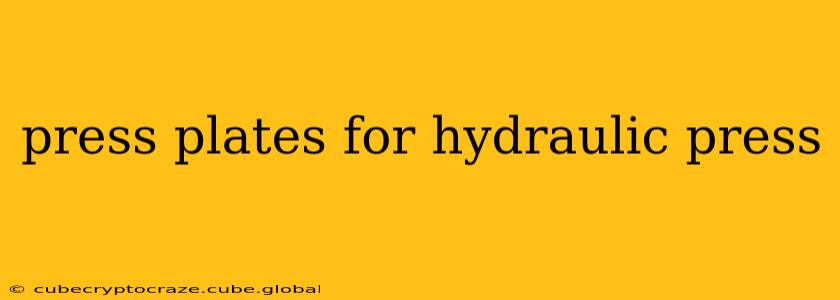Hydraulic presses are indispensable tools in various industries, from manufacturing and metalworking to automotive repair and recycling. A critical component ensuring the efficient and safe operation of these presses is the press plate. This guide delves into the world of press plates for hydraulic presses, covering their types, materials, selection, and maintenance.
What are Press Plates in a Hydraulic Press?
Press plates, also known as platens, are the large, flat surfaces on a hydraulic press where the work is performed. They bear the force exerted by the hydraulic ram, transmitting it to the workpiece. The design and material of these plates are crucial for the success of the pressing operation, impacting factors like accuracy, safety, and the lifespan of the press itself.
Different Types of Press Plates
Several types of press plates are available, each suited for specific applications:
-
Standard Press Plates: These are the most common type, typically made from steel and designed for general-purpose pressing operations. They're robust and reliable, offering a good balance between cost and performance.
-
Precision Ground Press Plates: Offering superior flatness and parallelism, these plates are essential for applications requiring high accuracy and tight tolerances. They are commonly used in processes like stamping and forming.
-
Speciality Press Plates: Depending on the application, specialized plates may be needed. These might include plates with cooling channels for high-temperature work, textured surfaces for improved grip, or plates with integrated features like tooling fixtures.
-
Modular Press Plates: These are designed for flexibility and easy configuration. They can be assembled in various sizes and configurations to accommodate different workpiece dimensions, making them ideal for shops handling diverse projects.
What Materials are Press Plates Made From?
The material of a press plate directly impacts its durability, performance, and resistance to wear. Common materials include:
-
Steel: A popular choice for its high strength, rigidity, and affordability. Different grades of steel are used depending on the application's demands for hardness, toughness, and wear resistance.
-
Cast Iron: Often used for larger press plates due to its excellent damping capacity, which can help reduce vibrations during pressing.
-
High-Strength Alloys: For extreme applications involving very high pressures or temperatures, specialized high-strength alloys provide the necessary resilience.
How to Choose the Right Press Plates for Your Needs
Selecting the appropriate press plates depends on several factors:
-
Press Capacity: The press plate must be able to withstand the maximum force exerted by the hydraulic ram.
-
Workpiece Dimensions: The plate size must be large enough to accommodate the workpiece and any necessary tooling.
-
Application Requirements: The choice of material and type will depend on the specific application, considering factors like temperature, pressure, and required accuracy.
-
Budget: Different materials and types of press plates vary significantly in cost.
Maintaining Your Press Plates for Optimal Performance
Proper maintenance of press plates is essential for extending their lifespan and ensuring safe operation:
-
Regular Inspection: Check for signs of wear, damage, or deformation during routine maintenance.
-
Cleaning: Keep the plates clean and free of debris to prevent damage and ensure proper contact with the workpiece.
-
Lubrication: Proper lubrication of moving parts can help prevent wear and extend the life of the plates.
-
Replacement: Replace damaged or worn-out plates promptly to avoid accidents and maintain the efficiency of the hydraulic press.
H2: What are the common causes of press plate damage?
Common causes of press plate damage include overloading the press beyond its rated capacity, using improper tooling, neglecting routine maintenance, and exposure to excessive heat or corrosive materials. Regular inspections and preventive maintenance are key to minimizing such damage.
H2: How often should press plates be inspected?
The frequency of inspection depends on the intensity of use and the specific application. However, regular visual inspections should be a part of routine maintenance, ideally performed daily or at least weekly. More detailed inspections involving measurements and testing might be necessary periodically depending on the press's workload and the material being processed.
H2: Can press plates be repaired?
Minor surface scratches or imperfections can sometimes be repaired through grinding or machining. However, significant damage, such as cracks or substantial deformation, usually requires plate replacement. Attempting to repair severely damaged plates can compromise safety and lead to further damage to the hydraulic press and potentially injure the operator.
H2: How do I know when it's time to replace my press plates?
Indicators for replacement include visible cracks, significant deformation, excessive wear, and signs of yielding or permanent deformation under pressure. If you observe any of these issues, it's crucial to replace the plates to prevent accidents and ensure the continued reliable operation of the hydraulic press. Consult the manufacturer's recommendations and safety guidelines.
This comprehensive guide offers valuable insights into press plates for hydraulic presses, equipping you with the knowledge to select, maintain, and utilize these critical components effectively. Remember, always prioritize safety and follow the manufacturer's guidelines for operating and maintaining your hydraulic press.
